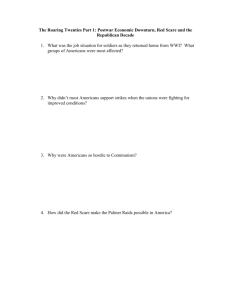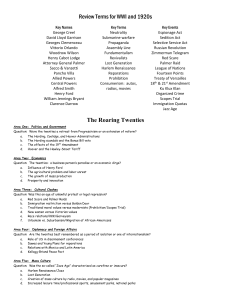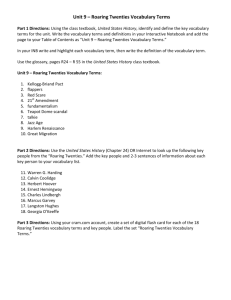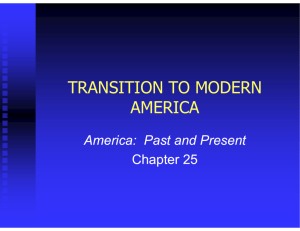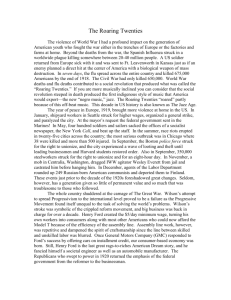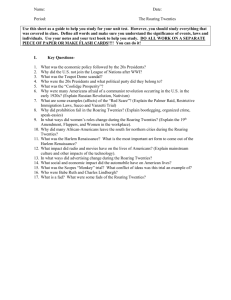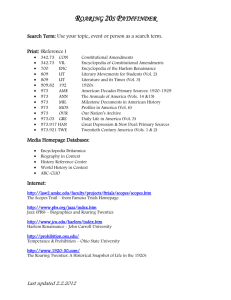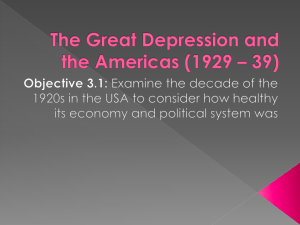The Roaring Twenties - Media Rich Learning
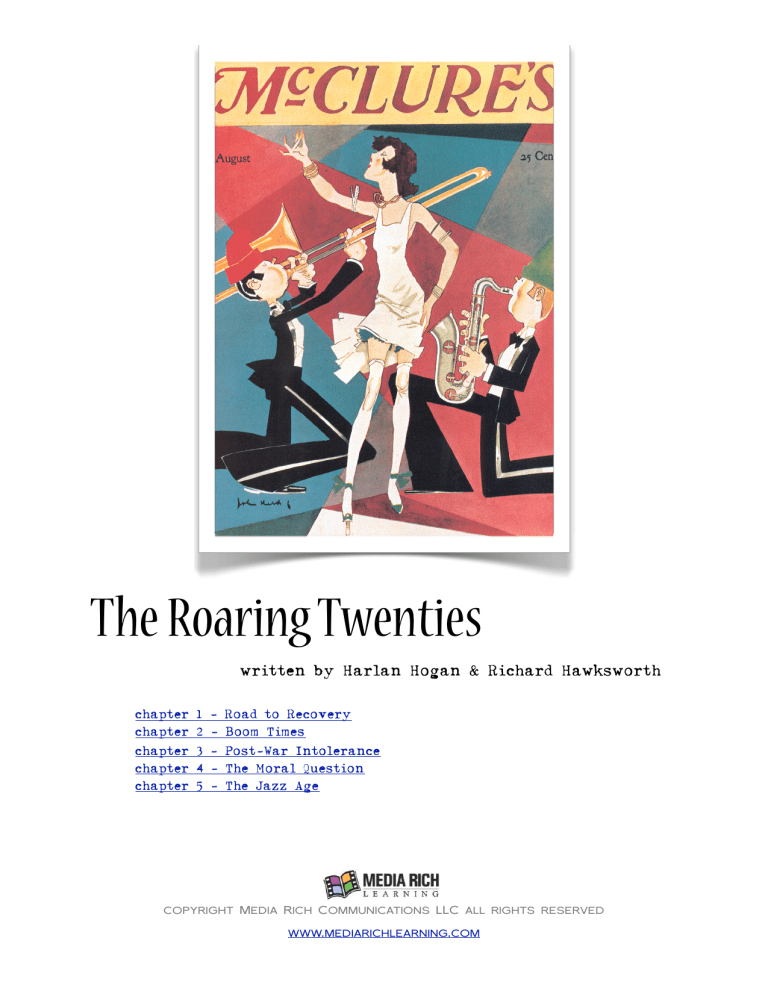
The Roaring Twenties
written by Harlan Hogan & Richard Hawksworth
chapter 3 - Post-War Intolerance
chapter 4 - The Moral Question
copyright Media Rich Communications LLC all rights reserved www.mediarichlearning.com
The Roaring Twenties
written by Harlan Hogan & Richard Hawksworth
It was a time of stark and sometimes startling contrasts, in American life. World War One was over.
Women got the right to vote. Fashion took a liberal turn. Alcohol was outlawed. Babe Ruth was king of the ballpark, Charles Lindbergh of the skies. Jazz filled the air - and the airwaves. And just about everybody who could afford it, went to the movies in “The Roaring ‘20s.”
Chapter 1 - Road to Recovery
The Roaring Twenties has the reputation as a decade of play and prosperity. Though unemployment was low and many Americans were better off financially, real wealth was concentrated among just a few families. Sixty percent of America's riches were owned by only two percent of the people. The 27,500 wealthiest families had as much money as the twelve million poorest. With the end of World War One, the country desperately wanted to return to normal. But prices shot upward with the increased demand for goods and services, while wages were still low due to a ban on raises and labor strikes during the war.
Now that the war had ended, strikes over higher wages resumed. In September 1919 Boston Police walked off patrol, citing lousy pay and long hours. Their subsequent absence triggered a free-for-all of looters and vandals. In turn, city officials granted no negotiation; the police force was replaced without the option to return. That same month 343,000 steel workers staged a nation-wide strike, only to taste a violent defeat. When substitute workers were hired, rioting erupted resulting in the mobilization of federal troops. Eighteen steelworkers lost their lives in the struggle; the walkout lasted four months with no reward. As labor unrest spread across the country some Americans felt it was being fostered by communists - radicals who believed in an economic and social system where prosperity is owned by everyone, and the needs of the whole are more important than those of the individual. Other citizens grew increasingly suspicious of immigrants, fearing they too, might be communists.
This so-called "Red Scare" was at a high during the Presidential election of 1919. And Ohio Lieutenant governor, Warren G. Harding's campaign promise of, "A return to normalcy" was just what the country wanted to hear and believe.
WARREN G. HARDING:
"America's present need is not heroics, but healing; not nostrums, but normalcy; not revolution but restoration..." copyright Media Rich Communications LLC all rights reserved www.mediarichlearning.com
Handsome, good-natured and well spoken, Harding and his running mate, Calvin Coolidge of
Massachusetts easily defeated the democratic ticket of James Cox and Franklin D. Roosevelt. Harding's proposal of a "return to normalcy” meant going back to pre-progressive era policies. He was opposed to the federal government's interference in business affairs, and most social reforms. He rejected Woodrow
Wilson's plea that America should actively participate in the League of Nations.
WARREN G. HARDING:
"We seek no part in directing the destinies of the Old World."
Harding's isolationist policy, keeping America out of world affairs, was popular and his successors,
Presidents Calvin Coolidge and Herbert Hoover followed his lead through the decade. Harding's cabinet was filled with pro-business appointees including Herbert Hoover, head of the Commerce Committee,
Charles Evans Hughes, Secretary of State and Andrew Mellon, Secretary of the Treasury.
In 1923 he presented Congress his, "Mellon Plan" which, on the surface, sought a general reduction in income taxes. In fact, the plan cut the top income tax bracket level from 50 per cent to 25, while only reducing the lowest bracket from four percent to three. Congressman William P. Connery of
Massachusetts was outraged.
WILLIAM P. CONNERY:
"When I see a provision in this Mellon tax bill which is going to save Mr. Mellon himself $800,000 on his income tax and his brother $600,000 on his, I cannot give it my support."
Nevertheless, the Mellon Plan passed, as did his proposal to raise tariffs on imported goods to one of the highest levels in history. Americans soon stopped buying foreign-made products and that made it almost impossible for France and Great Britain to repay their war debts to the United States. Meanwhile,
Secretary of Commerce Hoover aggressively helped American businesses recover from the war effort, while Secretary of State Hughes convinced the leading world powers to reduce the size of their navies.
Despite these recoveries and Harding's popularity, by the end of his third year scandal rocked his administration. His old poker buddies from Ohio, whom he'd handed jobs in government, were caught taking bribes. Harding expressed his disappointment.
WARREN G. HARDING:
"I have no trouble with my enemies...but my friends...they're the ones that keep me walking the floor nights."
The worst offense of the notorious, "Ohio Gang" involved Secretary of the Interior, Albert Fall. During the
Progressive Era, oil-rich public lands, located in Teapot Dome, Wyoming and Elk Hill, California were set aside for use by the Navy. Fall transferred control of those lands to his Interior Department and then copyright Media Rich Communications LLC all rights reserved www.mediarichlearning.com
secretly leased them to oil companies in exchange for a hundred thousand dollars in bonds, cattle and cash.
By the summer of 1923 - Harding, now saddened, confused and disillusioned by the betrayal of his friends, left Washington for a goodwill trip to Alaska. Upon his return to San Francisco, he became ill and died on August second.
Chapter 2 - Boom Times
Harding’s vice-president, Calvin Coolidge assumed office. A simple, honest, and quiet man he once joked about his subdued demeanor.
CALVIN COOLIDGE:
"I have never been hurt by what I haven't said.”
"Silent Cal" as Coolidge was nicknamed, was elected President one year later receiving almost 16 million votes, and would have easily won a second term, but unexpectedly decided not to run.
With Coolidge at the helm, continuing Harding's pro-business policies, it was "boom times" for the
American economy. Over forty percent on the world's wealth belonged to Americans, with eleven thousand millionaires living in America by 1926. Low interest rates meant that the construction of plants, homes and office buildings soared. By the end of the era, construction had begun on the mammoth 102 story Empire State Building.
Meanwhile, on the streets below, millions of Americans learned to drive. At the beginning of the Roaring
Twenties there were only eight million automobiles registered in the U.S. by the end of the decade, more than twenty three million. Henry Ford made a bold prediction.
HENRY FORD:
"When I'm through everybody will be able to afford one, and about everyone will have one."
America's new love affair with the car spurred production of rubber, steel, glass, and gasoline. A mobile
America wanted new roads, new destinations, and new places to live - the suburbs. Auto making became a major American industry. To meet demand automakers perfected the assembly line method of manufacturing and many other industries followed their lead. "Scientific Management" championed by
Frederick Taylor, revolutionized American business by identifying the most time-efficient ways to complete a task, increase production beyond the rate of technology.
Farmers adopted modern methods of production, but with an entirely different result. Larger, more efficient farms, utilizing more farm machinery than human laborers, created an overproduction of farm commodities. Many farmers had borrowed money to expand their farms and buy equipment when copyright Media Rich Communications LLC all rights reserved www.mediarichlearning.com
demand was high during the war. Now, falling prices and income forced many into bankruptcy.
Congressmen from farm states unified as "The Farm Bloc" and proposed price supports and legislation to aid farmers. Repeatedly, President Coolidge vetoed their attempts. Farmers wished that "Silent Cal" would just remain silent. His remarks brought them little consolation.
CALVIN COOLIDGE:
"Well, farmers have never made much money. I don't believe we can do much about it."
Urban workers were much better off than farmers, despite a decline in labor union membership, average wages increased by twenty percent. A more startling increase was in the number of homes with electricity. Between 1913 and 1927 the number grew by 465%. Soon, moderately priced electrical conveniences like vacuum cleaners, washing machines, and refrigerators were found in more and more
American households.
Chain stores like Sears and J.C. Penney did a brisk business selling ready-made clothes, and "grocerycafeterias," like Piggly Wiggly - the forerunner of the modern supermarket - offered everything from canned foods to sliced bread. Advertising lured consumers into the stores and readily available credit using the: "Installment Plan," made buying easy. Americans suddenly found they had much more time for community and leisure activities.
Telephones, and later, radios became common in most middle-class homes. Mass transit - streetcars and subways - provided mobility for city-dwellers and the airplane was used to move mail from coast to coast. In 1927, Charles Lindbergh flew his airplane, from continent to continent. "Lucky Lindy's" solo
3,614-mile flight across the Atlantic Ocean to Paris ensured his place as America's new hero. Four million people witnessed Charles Lindbergh's triumphant return to America, showering him with thousands of pounds of ticker tape, as he paraded up Broadway. Lindbergh's flight also captured the imagination of the public and stirred their interest in flying.
CHARLES LINDBERGH:
"I look forward to the day when transatlantic flying will be a regular thing."
Soon, the single-engine Lockheed Vega and the Ford Tri-Motor airplanes were carrying as many as ten passengers. An already mobile America, became even more so. By the end of the Roaring Twenties 43 airlines were operating in the United States.
Chapter 3 - Post-War Intolerance
Despite the economic boom times, the Roaring Twenties was a period of great tension between
Americans. Social, racial and moral beliefs were constantly being challenged. A fear of communism, copyright Media Rich Communications LLC all rights reserved www.mediarichlearning.com
socialism and anarchy, fueled by a distrust of any foreigner, led to one of the most notorious convictions and executions in American history.
Two Italian immigrants shoemaker, Nicola Sacco and fishmonger, Bartolomeo Vanzetti were accused of robbing and killing a factory paymaster and a guard. Sacco and Vanzetti admitted to being anarchists - people who want to abolish all forms of government - and to being draft dodgers during World War One.
However, both maintained they had not committed the crime. On the basis of circumstantial evidence,
Sacco and Vanzetti were convicted and executed. Their guilt or innocence is still debated today.
Guilty or not, the case personified the fear Americans had of immigrants. Some paranoid citizens felt immigrants took jobs rightfully belonging to American citizens, others felt too many immigrants were political radicals.
Between 1919 and 1921 the yearly number of new immigrants had shot up, from 141,000 to 805,000 and Congress bowed to the pressure of Americans with nativist attitudes, by passing a new law limiting immigration into the U.S. Additional restrictions were imposed three years later, when the National
Origins act of 1924 further limited immigration. The acts discriminated against people from eastern and southern Europe, mostly Roman Catholics and Jews and excluded the immigration of Japanese citizens altogether. The laws did not apply to immigrants from the Western Hemisphere however, and approximately one million Canadians and a half a million Mexicans crossed the borders into the U.S.
The increasing popularity of nativism also stirred the resurgence of the Ku Klux Klan, whose members had tormented and killed many African-Americans in the South after the Civil War. The "new" Klan extended their bigotry to anyone not American, not Protestant, not white, while attempting to stamp out unions and saloons. By 1924, it boasted a membership of more than four million members. The imperial wizard of the KKK summed up the Klan's doctrine succinctly in his 1926 booklet, "The Klan's Fight for
Americanism" when he revealed the Klan's slogan: Native, white, Protestant, supremacy. Although the
KKK dominated certain state politics at times during the roaring twenties, its popularity waned after
Indiana Klan chieftain, D.C. "Steve" Stevenson, was indicted and jailed for a brutal assault on a female assistant. The resulting scandal and his conviction for second-degree murder signaled the decline of
Klan's political influence and, by the end of the decade, membership had dwindled to only fifty thousand.
While the hateful Ku Klux Klan was growing in popularity a peaceful separatist movement was gaining a large group of followers - Garveyism. Marcus Garvey, a Jamaican, founded the Universal Negro
Improvement Association in 1914. He moved his organization to New York and by the mid-1920s there were more than a half a million members. The association had two central beliefs: The first was that blacks should return to Africa and build a homeland of their own. Garvey had even designed a uniform for himself as the, "Provisional President of Africa." Second, Garvey insisted his followers should not envy or imitate whites or seek integration. "Black is beautiful" he declared, "and you are better than white people." Garvey started a successful newspaper and a steamship company to help raise funds for the cause, but the steamship company, The Black Star, failed. He was convicted of mail-fraud, and sent copyright Media Rich Communications LLC all rights reserved www.mediarichlearning.com
to prison. Only a handful of his followers actually returned to Africa, but Marcus Garvey's fundamental belief in the dignity and pride deserved by all African Americans certainly lives on.
Chapter 4 - The Moral Question
The Roaring Twenties marked the first time in American history when more people lived in cities and towns than in rural areas. Americans moving to cities from small villages had to adapt not only to new and challenging physical living conditions they encountered a new, more permissive moral environment as well. Two events fittingly demonstrate the clash between traditional moral values of the country and the modern mores of the city: the Scopes Trial and Prohibition.
In 1925, the state of Tennessee passed a law that outlawed any teaching English biologist Charles
Darwin's theory of evolution. Darwin's book, The Origin of Species challenged contemporary beliefs about creation and outraged fundamentalist Christians' literal interpretation of the bible believing God created the universe in six days. John Scopes, a high school biology teacher from Dayton, Tennessee believed Darwin was right and, despite the state law, taught his students the theory of evolution. As a result, Scopes was charged under the anti-evolution statute and went to trial for the misdemeanor.
The American Civil Liberties Union or ACLU, which had been founded during the "Red Scare" earlier in the decade, hired the most renowned trial lawyer of the day, Clarence Darrow to defend Scopes. The prosecutor was equally well known, William Jennings Bryan, a three-time candidate for President, skilled orator and fundamentalist Christian. The press had a field day and called it the, "Monkey Trial" as the big-city reporters repeatedly made fun of rural values. Darrow defended his stance.
CLARENCE DARROW:
"We have the purpose of preventing bigots and ignoramuses from controlling the education of the United
States, and you know it, and that is all."
Although the judge found John Scopes guilty of violating the state's law, many felt that Clarence Darrow had actually won the case because he had managed to get William Jennings Bryan to admit on the stand, that he did not actually believe the earth was created in six 24 hour days. The Tennessee
Supreme court later overturned the verdict on a technicality and Scopes was set free, but the debate over teaching the theory of evolution in schools still continues.
Americans with conservative, traditional values succeeded in convincing Congress to prohibit the sale and use of alcohol. But prohibition," the noble experiment” as Herbert Hoover dubbed it, simply didn't work. On January 16th, 1920 the eighteenth amendment to the constitution was passed outlawing the manufacture, sale or transportation of alcoholic beverages. The amendment was supported mainly by rural Americans, from the South and Southwest, who believed drinking to be a sin. Urban city dwellers generally saw drinking as a natural part of life and the use of alcohol as an individual's decision.
Evangelist Billy Sunday spoke for many prohibitionists.
copyright Media Rich Communications LLC all rights reserved www.mediarichlearning.com
Billy Sunday
Every man who casts a vote for the saloons deserves that his son shall die a drunkard, or that his daughter should be consigned to the tender mercies of a drunken husband.
Billy Sunday got his wish when Prohibition became the law of the land. But Prohibition did not stop people from drinking alcohol. Many went to "Speakeasies," hidden illegal clubs, and drank liquor smuggled in by "bootleggers" from Canada. Organized crime, which provided illegal "booze" or "hooch" flourished and Prohibition, incited more crime, not less. Thirteen years later the "Noble Experiment" was over.
Chapter 5 - The Jazz Age
The Roaring Twenties are often called: "The Jazz Age" a time when new forms of art like jazz, emerged with a distinctly American flare. Anti-war literature like Ernest Hemmingway's The Sun Also Rises found favor with Americans, as did the writing of F. Scott Fitzgerald, who's Great Gatsby depicted the new
American dream of wealth and success, while Sinclair Lewis examined the realities of life in small-town
America, revealing its greed and lack of culture. On the stage, ground breaking playwrights like Eugene
O'Neill presented dramas that focused on family conflict and isolation in the modern age. Artists such as
Georgia O'Keeffe depicted life in urban America in the twenties.
Nowhere, was America's uniqueness more evident than in her music. From George Gershwin's instant success with Rhapsody in Blue and Concerto in F, to the phenomenal growth of a truly American musical form: Jazz.
Jazz was born in New Orleans in the early part of the century, a blend of the blues and ragtime.
Migrating African-Americans brought this new music to the north. A great many settling in the upper west side of New York City in an area called: Harlem. Harlem, became the center not only for Jazz, it became the heart of African-American creativity during the "Harlem Renaissance." From poets like
Langston Hughes, to performers like Duke Ellington to songstress Bessie Smith who sold a million recordings of Down Hearted Blues. By 1927 Smith was the highest-paid African-American performer in the world. Singer, dancer, comedian, Josephine Baker on the other hand chose to live and work in Paris, spreading the influence of the Harlem Renaissance even to Europe.
Women and men found pleasure and entertainment listening to the radio. And for many, radio became their main source of news about the world.
Americans were also leaving their homes to find new entertainment, at the movies. By 1925 filmmaking had become the nation's fourth-largest industry, and there were more than twenty thousand movie houses nationwide many of them elaborate, "Picture Palaces."
Women saw also a new image emerge for them in the Roaring Twenties - "The Flapper." Having finally gotten the right to vote with the passage of the nineteenth amendment to the Constitution. Emancipated copyright Media Rich Communications LLC all rights reserved www.mediarichlearning.com
women threw out their corsets, high-laced shoes and dull floor length dresses. They bobbed their hair, and wore short skirts.
A woman of the Roaring Twenties also had new choices. She didn't necessarily have to be a housewife anymore. Instead she could choose whether to marry at all, have children, go to work or build a career.
Marriage became more of a romantic choice. Equality was not prevalent in the work force, with women usually earning much less than men, even when they performed the same job. Medical schools went so far as to impose strict quotas on the number of women allowed to enter.
Americans were also reading. Eight million more Americans were reading newspapers by the midtwenties, many enjoying, tabloids and magazines that featured sensational stories about gangsters and entertainers. By the end of the decade, ten magazines had circulations of more than two million. Literacy was on the rise. The number of people attending high school had quadrupled since 1914 and High school was no longer just for college-bound students.
Americans also discovered the pleasures of watching professional sports, from baseball's Leroy
"Satchel" Paige, to boxing's "Manassa Mauler," Jack Dempsey.
Entertainment of all kinds became part of the legacy of the Roaring Twenties, as Americans spent over
4.5 billion dollars on entertainment, much of it on pastimes and fads. Some of those fads, like flagpole sitting, or dance marathons that seem so silly now. These images of an almost adolescent America, finally free of the fear and drudgery of war, are how most people view the Roaring Twenties, and in fact, it was a brief period of relative prosperity.
Unfortunately, despite the outward appearance of stability, the American economy was crumbling and by late 1929 would be brought to its knees by the start of "The Great Depression." But until the stock market crashed, the twenties were indeed roaring.
copyright Media Rich Communications LLC all rights reserved www.mediarichlearning.com
Look for other educational documentaries from the award-winning team at Media Rich Learning:
America in the 20th Century
America Becomes a World Power
The Progressive Era
World War I
The Roaring Twenties
The Great Depression
World War II
The Post-War Years
Vietnam
Cold War
The Sixties
To Register your copy of America in the 20th Century, visit us online
www.mediarichlearning.com
You’ll be eligible for password-only access to additional primary source video clips and bonus chapters available only online.
copyright Media Rich Communications LLC all rights reserved www.mediarichlearning.com

